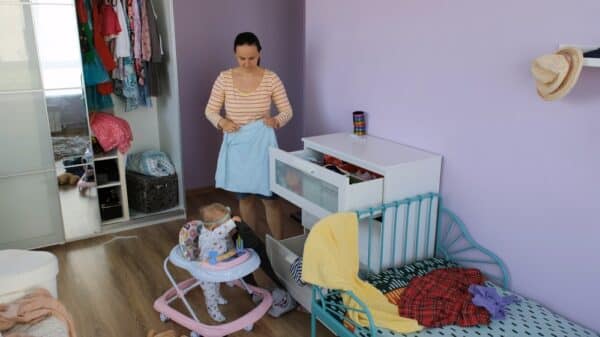The first few weeks of transitioning to daycare can feel like navigating a whirlwind of emotions—not just for your little one but for you as well. You might find yourself anxiously watching for signs of your child settling in, but knowing what a healthy adjustment actually looks like isn’t always straightforward. To shed some light on this challenging process, we turned to Michaela LeRoy, an Education and Development Specialist at Haven. Haven is a first-of-its-kind fully licensed daycare in the U.S. that offers flexible childcare alongside on-site coworking and fitness facilities. LeRoy emphasizes that understanding the nuances of this transition can make all the difference for parents trying to support their children.
The early days of daycare transition: What actually matters
“Every child’s adjustment phase is unique,” LeRoy explains. “Some kids might settle in after just a few days, while others could take several weeks to feel truly comfortable.” However, there’s one key element that signifies a successful transition: trust. This might come as a relief, especially when you’ve witnessed those first tentative steps into a new classroom.
“A significant early indicator of adjustment is when a child turns to their teacher for comfort,” she notes. “Trust presents itself in subtle yet powerful ways—whether it’s a child accepting help, exploring their new environment, or seeking the warmth of a teacher when they feel uncertain.”
Curiosity is another crucial sign to look out for. “Children begin to take notice of their surroundings and the new friendships blossoming around them. They might start imitating others or engage in parallel play, showing their eagerness to connect. Over time, familiarity with daily routines, like snack time or outdoor play, can help them find comfort in their new environment.”
It’s worth noting that these indicators of adjustment might not emerge during drop-off times. Your child might still show signs of distress as you leave, but often once a parent or guardian departs, they can redirect their energy and engage more fully with the day ahead.
The home truth: What your living room reveals
While observing behaviors in the classroom is critical, LeRoy emphasizes that some of the most telling signs of adjustment happen at home. She identifies four key aspects to keep an eye on:
- Talking About School: When your child comes home bubbling with tales from their day—whether it’s about a fun activity or a game with new friends—it’s a positive sign that they’re beginning to adapt.
- Imitation: If you catch your child singing songs or reenacting stories from school, or using phrases they learned from their teachers or peers, it’s an indication they’re absorbing their experiences.
- Excited to Return: If your little one expresses genuine excitement about going back to school to see their friends and teachers, that’s a clear indication of adjustment.
- Natural Tiredness: After a stimulating day at daycare, if your child seems more tired than usual and transitions smoothly to bedtime, it’s often a sign that they’ve had a fulfilling experience.
Understanding your child’s unique timeline
Many parents find themselves wondering, “How long is too long for my child to adjust?” LeRoy reminds us that temperament plays a critical role. “Each child has a unique way of responding to the world, whether they are easygoing, slow-to-warm, or highly sensitive.” This means that adjustment can look very different depending on your child’s personality.
For instance, a child who is naturally adaptable might dive right into play right after you leave, without shedding a tear, while a highly sensitive child may show initial signs of adjustment through subtler cues, like a shy smile or quietly joining in with peers.
So, what’s the typical timeline? “Many kids start to show signs of adjustment within the first two to four weeks,” LeRoy notes. However, keep in mind that for highly sensitive children, it might take longer—sometimes well over a month—before those positive signs start to emerge. Adjustment is a gradual journey, unfolding in small steps rather than a single leap forward.
When words reveal connection
As your child settles in, listen closely to their words; they can offer valuable insights. “When children start sharing details about their experiences in the classroom, it showcases they’re building positive relationships at school,” LeRoy points out. Kids might excitedly talk about the fun activities they did or repeat phrases they’ve heard from teachers or friends.
The best signs of connection? “When children express enthusiasm about returning to school, eager to reunite with friends and teachers, or lovingly refer to their classmates by name or even use nicknames, it indicates strong social bonds and a growing sense of belonging.”
Green flags in daily conversations
LeRoy identifies certain conversational patterns that reveal healthy adjustment: “If your child frequently speaks fondly of their teachers and friends, that’s a reassuring sign that they feel secure and connected. Listening for specifics can further confirm this; for example, a child might excitedly recount a special moment they shared with a teacher, like building a block tower, or drawing together.”
When discussing peer relationships, consider how your child conveys their interactions. “If they mention a classmate by name and describe their shared playtime, it demonstrates a blossoming sense of community and belonging. Another key signal is moments of joy—expressions like ‘I can’t wait to go back to school’ highlight strong friendships and positive social adjustment.”
Supporting without overwhelming
Wondering how to encourage your child to share about their day without adding pressure? LeRoy offers helpful strategies: “One of the most effective ways families can contribute to their child’s adjustment is by speaking positively about school. When children hear their parents frame school as a safe and enjoyable place, they are more likely to feel comfortable opening up.”
The way you ask questions can influence what your child shares: “Opt for simple, open-ended questions rather than ones that might lead to negativity. Questions like ‘Who did you sit with at snack time today?’ or ‘What was your favorite activity outside?’ encourage children to share freely without feeling cornered.”
And just a reminder: Keep conversations about school light and encouraging, allowing your child the space to talk without feeling overwhelmed.
When intellectual curiosity blooms
In addition to social connections, LeRoy points out signs that indicate your child’s intellectual engagement in their new environment:
- Curiosity: A child begins asking questions, experimenting with toys, and diving into new activities with enthusiasm, revealing their eagerness to learn more.
- Focus: You might notice your child staying engaged with a particular activity for longer periods, enjoying the process of exploration.
- Creativity: If they express themselves through drawing, building, or creating projects that are uniquely theirs, it signals imaginative growth.
- Love of Learning: When your child proudly shares their discoveries and creations with you or their friends, it’s a clear indicator they’re thriving in a learning environment.
Ultimately, every child’s journey through daycare is a personal one, colored by their temperament, experiences, and your unwavering support. As you navigate these transitional weeks, keep your eyes peeled for those subtle yet powerful signs of adjustment—each one a beautiful milestone marking your child’s growing independence and confidence.
Navigating drop-off and pickup can often feel like a high-stakes game. You want to be there for your little one while also respecting the rhythm of the classroom. LeRoy offers keen insights on how parents and guardians can turn these everyday transitions into meaningful opportunities for understanding their child’s adjustment to school.
Observation is key. As you drop off or pick up your child, pay attention to those subtle cues that might tell you how they’re doing. Are they bouncing with energy, or do they seem a bit withdrawn? Their body language and mood can reveal a lot about their comfort level. While it’s natural to be curious about their day, LeRoy emphasizes the importance of timing. Those quick exchanges at the door can provide some insight, but it’s best to save the in-depth conversations for scheduled meetings with their teacher. After all, the focus during these moments should be on the children, not the adults.
When it comes to goodbyes, keeping them brief can make a world of difference. It’s tempting to linger, especially when you see those big, trusting eyes looking back at you, but prolonged goodbyes can make the separation tougher. A quick farewell can reassure your child that school is a place of safety and comfort, helping them to embrace their time away from home.
Moving on to the social aspect, LeRoy points out that early childhood is a golden opportunity for social skills to blossom. School isn’t just about learning the ABCs; it’s a vibrant space where friendships are formed and essential skills like sharing and taking turns are practiced daily. When children come home buzzing with stories about new friends or fun activities, it’s a sign they’re not just adjusting but thriving. Trusting relationships built in this environment significantly influence how children view themselves and relate to others.
However, as a parent, it’s important to know when to worry and when to just let things be. It’s entirely normal for children to show signs of anxiety or clinginess when starting a new school. These reactions are typical, and over time, most children will adapt and feel more secure. But if you notice persistent distress or withdrawal from peers and school activities, it’s worth discussing these concerns.
Every child adjusts at their own pace. Some may settle in quickly, while others could take weeks or even months. What truly matters is their progress. Look for those small milestones—maybe your child is crying less or joining in more playful interactions. Each tiny step forward signifies growth in their adjustment journey.
Ultimately, LeRoy reminds us that the key is open communication and trusting the process. If you have any concerns about your child’s adjustment, don’t hesitate to reach out to their teacher or childcare director. Everyone involved can come together to ensure your child feels supported during this transitional time.
Remember, it’s not about achieving a perfect adjustment overnight. It’s about building connections, taking gradual steps, and fostering the trust that transforms daycare into a nurturing second home. You’re in this together with your child; every little progress is a shared victory.
Image Source: Unsplash



































